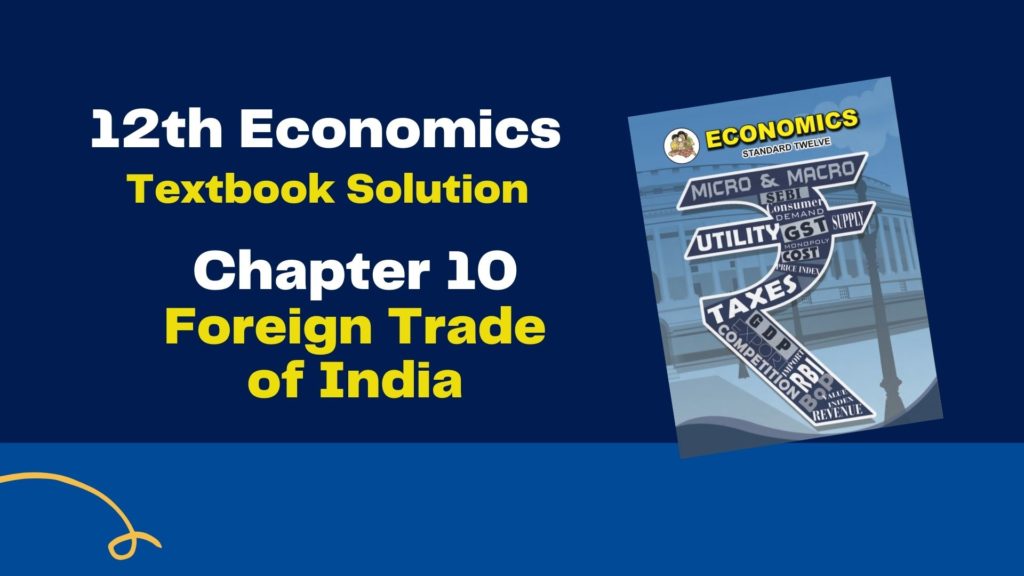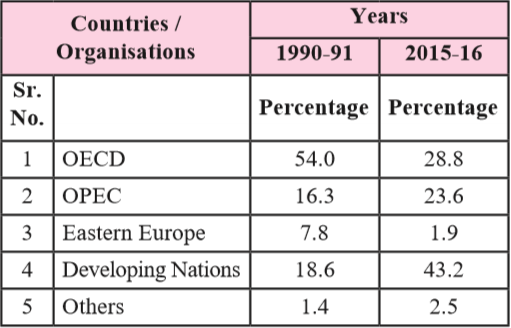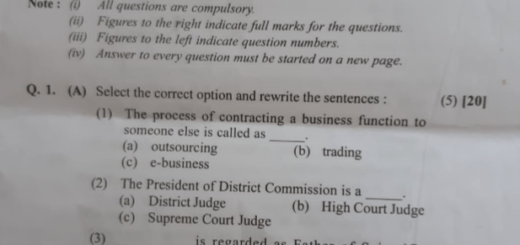12th Economics Chapter 10 Solutions (Foreign Trade of India) Maharashtra Board – Free Solution
Table of Contents
12th Economics Chapter 10 Solutions

Chapter 10 – Foreign Trade of India
Q. 1. Choose the correct option
1) Types of foreign trade
a) Import trade
b) Export trade
c) Entrepot trade
d) Internal trade
Options :
1) a and b
2) a, b and c
3) a, b, c and d
4) None of these
2) Export trends of India’s foreign trade includes
a) Engineering goods
b) Gems and Jewellery
c) Textiles and ready-made garments
d) Gold
Options :
1) a and c
2) a, b and c
3) b, c and d
4) None of these
3) Role of foreign trade is
a) To earn foreign exchange
b) To encourage investment
c) Lead to division of labour
d) Bring change in composition of exports
Options :
1) a and b
2) a, b and c
3) b and d
4) None of these
Q. 2. Identify and explain the concepts from the given illustrations
1) India purchased petroleum from Iran.
Identified Concept: Import Trade.
Explanation: Import trade refers to the purchase of goods and services by one country from another country or inflow of goods and services from a foreign country to the home country.
2) Maharashtra purchased wheat from Punjab.
Identified Concept: Internal/Home Trade.
Explanation: The buying and selling of goods and services within the boundaries of a nation are referred to as ‘Internal Trade’ or ‘Domestic Trade’ or ‘Home Trade’.
3) England imported cotton from India, made readymade garments from it, and sold them to Malaysia.
Identified Concept: Entrepot Trade.
Explanation: Entrepot trade refers to the purchase of goods and services from one country and then selling them to another country after some processing operations.
4) Japan sells smartphones to Myanmar.
Identified Concept: Export Trade.
Explanation: Export trade refers to the sale of goods by one country to another country or the outflow of goods from one country to a foreign country.
Solution of other subjects
Solution of all Chapters of Economics
1 – 2 – 3A – 3B – 4 – 5 – 6 – 7 – 8 – 9 – 10
Q.3. Distinguish between the following
1) Internal trade and International trade.
| Points | Internal Trade | International trade |
| 1)Meaning | Buying and selling of goods and services within the boundaries of a nation are referred to as ‘Internal Trade’ or ‘Domestic Trade’ or ‘Home Trade’. | Foreign Trade is trade between the different countries of the world. It is called as International Trade or External Trade. |
| 2) Use of Currency | Domestic currency is used for buying and selling goods and services in internal trade. | Foriegn currency is used for buying and selling goods and services in international trade. |
2) Trends in imports and Trends in exports of foreign trade.
| Points | Trends in imports of foreign trade | Trends in Exports of foreign trade |
| 1)Meaning | Import trade refers to purchase of goods and services by one country from another country or inflow of goods and services from foreign country to home country. | Export trade refers to the sale of goods by one country to another country or outflow of goods from one country to foreign country. |
| 2) Share | Petroleum has the highest share in India’s imports. (31% at present) | Engineering goods has the highest share in India’s imports. (25% in 2017-18) |
| 3) Products | Import of petroleum is still rising while that of gold, fertilizers, iron, and steel has declined over time. | Export of engineering goods, petroleum/chemical products, gems, and jewellery, and textile have increased over time. |
3) Balance of payments and Balance of trade.
| Points | Balance of payments | Balance of trade |
| 1)Meaning | The Balance of payments of a country is a systematic record of all international economic transactions of that country during a given period, usually a year. | Balance of trade is the difference between the value of a country’s exports and imports for a given period. Balance of trade is also referred to as the international trade balance. |
| 2) Concept | Balance of trade is included in the balance of payment. Therefore, balance of payments is a broader concept. | Balance of trade is a part of balance of payments. Therefore, the balance of trade is a narrower concept. |
Q.4. Answer the following
1) Explain the concept of foreign trade and its types.
Answer: Foreign Trade is traded between the different countries of the world. It is called International Trade or External Trade.
1) Import Trade:
Import trade refers to purchase of goods and services by one country from another country or inflow of goods and services from a foreign country to home country. For example, India imports petroleum from Iraq, Kuwait, Saudi Arabia, etc.
2) Export Trade:
Export trade refers to the sale of goods by one country to another country or outflow of goods from one country to a foreign country. For example, India exports tea, rice, jute to China, Hong Kong, Singapore etc.
3) Entrepot Trade:
Entrepot trade refers to the purchase of goods and services from one country and then selling them to another country after some processing operations. For example, Japan imports raw materials required to make electronic goods like, radio, washing machines, television etc. from England, Germany, France etc. and sells them to various countries in the world after processing them.
2) Explain any four features of the composition of India’s foreign trade.
.Answer: Over the last 70 years, India’s foreign trade has undergone a complete change in terms of
composition and direction. The main features of composition of India’s foreign trade is as follows
1) Increasing share of Gross National Income:
In 1990-91, share of India’s foreign trade (import-export) in gross national income was 17.55%. It increased to 25% during 2006-07 and to 48.8% during 2016-17.
2) Increase in volume and value of trade:
Since 1990-91, the volume and value of India’s foreign trade has gone up. India now exports and imports goods which are several times more in value and volume.
3) Change in the composition of exports:
Since Independence, the composition of export trade of India has undergone a change. Prior to Independence, India used to export primary products like jute, cotton, tea, oil seeds, leather, foodgrains, cashew nuts and mineral products. With the passage of time, manufactured items like readymade garments, gems and jewellery, electronic goods, especially computer hardware and software occupies a prime place in India’s exports.
4) Change in the composition of imports:
Prior to independence, India used to import consumer goods like medicines, cloth, motor vehicles, electrical goods etc. A part from petrol and petroleum, India is now importing mainly capital goods like high-tech machinery chemicals, fertilizers, steel etc.
5) Oceanic trade:
Most of India’s trade is by sea. India has trade relations with its neighbouring countries like Nepal, Afghanistan, Myanmar, Sri Lanka etc. The share of India’s oceanic trade is around 68%.
6) Development of new ports:
For its foreign trade, India depended mostly on Mumbai, Kolkata and Chennai ports. Therefore, these ports were overburdened. Recently, India has developed new ports at Kandla,
Cochin, Vishakhapatnam, Nhava Sheva etc. to reduce the burden on the existing ports.
3) Explain the trend in India’s imports.
Answer: Following are the recent trends in India’s imports.
1) Petroleum:
Petroleum has always remained the most important item of imports in India’s trade in the pre as well as post reform period. It had a share of 27% in total imports in 1990-92 which currently stands at around 31%.
2) Gold:
After petroleum, the second most imported item is gold. It has been observed that there is a significant drop in gold imports during 2013-14. The gold imports declined from 53.3 billion dollars in 2011-12 to 27.5 billion dollars in 2013-14. This was primarily due to fall in international gold prices and various policy measures taken by the government to curb gold imports.
3) Fertilizers:
The share of fertilizers in import expenditure declined from 4.1% in 1990-91 to only 1.3% in 2016-17.
4) Iron and Steel:
The share of iron and steel in import expenditure declined from 4.9% to 2.1% in 2016-17.
Solution of other subjects
Solution of all Chapters of Economics
1 – 2 – 3A – 3B – 4 – 5 – 6 – 7 – 8 – 9 – 10
Q.5. State with reasons whether you agree or disagree with the following statements
1) During British rule, indigenous handicrafts suffered a severe blow.
Ans: Yes, I agree with this statement.
Reason: a) Before 1947, the pattern of India’s foreign trade was typically colonial.
b) India was a supplier of raw materials to the industrialized nations, particularly England and an importer of
manufactured goods.
c) This dependence on foreign trade did not permit industrialization at home.
d) As a result the indigenous handicrafts suffered a severe blow.
2) Trade is an engine of growth for an economy.
Ans: Yes, I agree with this statement.
Reason: a) Trade is an engine of growth of an economy because it plays an important role in economic
development.
b) Foreign trade provides foreign exchange which can be used for very productive purposes.
c) Foreign trade creates an opportunity for the producers to reach beyond the domestic markets.
d) Foreign trade leads to the division of labour and specialization at the world level.
e) Thus, Trade is an engine of growth for an economy.
3) Foreign trade leads to division of labour and specialization at world level.
Ans: Yes, I agree with this statement.
Reason: a) Foreign Trade is trade between the different countries of the world.
b) Some countries have abundant natural resources.
c) They should export raw materials and import finished goods from countries that are advanced in skilled manpower.
d) Thus, foreign trade gives benefits to all countries thereby leading to division of labour and specialization.
Q.6. Observe the following table and answer the questions given below it.
Direction of India’s imports

1) Which organisation has the least share in the direction of India’s imports in 2015-16?
Answer: Eastern Europe has the least share in the direction of India’s imports in 2015-16
2) Which organisation has the maximum share in India’s direction of imports in 1990-91?
Answer: OECD has the maximum share in India’s direction of imports in 1990-91.
3) Expand the abbreviations of OECD and OPEC.
Answer: (OECD) The Organisation of Economic Cooperation and Development. (OPEC) The organisation of Petroleum Exporting Countries.
4) State your opinion regarding the direction of India’s imports.
Answer: The imports from OECD and Eastern Europe has declined from 1990-91 to 2015-16 and imports from OPEC, Developing Nations and Other countries have increased from 1990-91 to 2015-16.
5) How much is the percentage of increase in the imports of developing nations in 2015-16 as compared to 1990-91?.
Answer: The percentage of increase in the imports of developing nations in 2015-16 as compared to 1990-91 is by 24.6 per cent.
Q.7. Answer in detail
1) Explain the meaning and role of foreign trade.
Answer: Foreign Trade is trade between the different countries of the world. It is called as International
Trade or External Trade.
The role of foreign trade can be justified based on the following points:
1) To earn foreign exchange:
Foreign trade provides foreign exchange which can be used for very productive purposes. Foreign trade is a remarkable factor in expanding Foreign Trade of India the market and encouraging the production of goods.
2) Encourages Investment:
Foreign trade creates an opportunity for the producers to reach beyond the domestic markets. It encourages them to produce more goods for export. This leads to an increase in total
investment in an economy.
3) Division of labour and specialization:
Foreign trade leads to the division of labour and specialization at the world level. Some countries have abundant natural resources, they should export raw materials and import finished goods from countries that are advanced in skilled manpower. Thus, foreign trade gives benefits to all countries thereby leading to the division of labour and specialization.
4) Optimum allocation and utilization of resources:
Due to specialization, resources are channelized for the production of only those goods which would give the highest returns. Thus, there is rational allocation and specialization of resources at the international level due to foreign trade.
5) Stability in price level:
Foreign trade helps to keep the demand and supply position stable which in turn stabilizes the price level in the economy.
6) Availability of multiple choices:
Foreign trade provides multiple choices of imported commodities. As foreign trade is highly competitive it also ensures good quality and standard products. This raises the standard of living of people.
7) Brings reputation and helps earn goodwill:
Exporting countries can earn reputation and goodwill in the international market. For example, countries like Japan, Germany, Switzerland etc. have earned a lot of goodwill and reputation in foreign markets for their qualitative production of electronic goods.
2) Explain the recent trends in India’s exports.
Answer: Export trade refers to the sale of goods by one country to another country or outflow of goods from one country to foreign country.
The recent trends in India’s exports are as follows.
1) Engineering goods:
According to Engineering Goods Export Promotion Council (EGEPC) Report, the share of engineering goods was 25% in India’s total exports in 2017-18. Within this category some of the prominent exported items are transport equipment including automobiles and auto components, machinery and instruments. During the period 2010-11 to 2014-15, exports of transport equipment have grown from 16 billion dollars to 24.8 billion dollars.
2) Petroleum products:
India’s petroleum capacity increased significantly since 2001-02, due to which India turned as a net exporter of petroleum refinery products. Petroleum products had a share of 4.3% in India’s total exports in 2000-01, which rose steadily to 20.1% in 2013-14.
3) Chemicals and chemical products:
An important export item that has performed reasonably well over the last few years is chemicals and chemical products. The share of this item was 10.4% in 2014-15.
4) Gems and Jewellery:
Gems and jewellery is one of the major contributors to export earnings in India, having a share of 13.3% in India’s merchandise export in 2014-15.
5) Textiles and readymade garments:
Textiles and garment exports together accounted for 11.3% of India’s exports in 2014-15. In fact, India is one of the leading exporting countries of textiles and readymade garments in the world.
Extra Questions
Answer the following questions.
1) Explain the Concept of Balance of payments.
Answer:
a) The Balance of payments of a country is a systematic record of all international economic transactions of that country during a given period, usually a year.
b) According to Ellsworth, “Balance of payments is a summary statement of all the transactions between the residents of one country and the rest of the world.
c) According to Walter Krause, “The balance of payments of a country is a systematic record of all economic transactions completed between its residents and the rest of the world during a given period of time usually a concept of the year.
d) From the above definitions, it is clear that the value of exchange of goods and services among the citizens, businessmen, firms, government, etc. is included in balance of payments
2) Explain Balance of Trade.
Answer:
a) Balance of trade is the difference between the value of a country’s exports and imports for a given period.
b) Balance of trade is also referred to as the international trade balance.
c) According to Bentham,“Balance of trade of a country is the relation over a period between the values of her exports and imports of physical goods.”
d) According to Samuelson, “if the export value is greater than the import value it is called as trade surplus and if import value is greater than export value, then it is called as trade deficit.”
e) It is clear from the above definitions that balance of trade includes the value of imports and exports of visible goods and invisible goods.
Solution of all Chapters of Economics
| Chapter Name | Solution Link |
| 1) Introduction to Micro and Macro Economics | Click Here |
| 2) Utility Analysis | Click Here |
| 3A) Demand Analysis | Click Here |
| 3B) Elasticity of Demand | Click Here |
| 4) Supply Analysis | Click Here |
| 5) Forms of Market | Click Here |
| 6) Index Numbers | Click Here |
| 7) National Income | Click Here |
| 8) Public Finance in India | Click Here |
| 9) Money Market and Capital Market in India | Click Here |
| 10) Foreign Trade of India | Click Here |
Check out other posts related to the 12th Commerce
| Textbook Solutions of 12th Commerce (All Subjects) | Click Here |
| Free pdf of 12th Commerce Textbooks | Click Here |
| 12th Commerce IT MCQ Preparation (Online Test) | Click Here |
| 12th Commerce Paper Pattern and Chapter Wise Marks Distribution | Click Here |
| Sample Paper of 12th Commerce for Practice | Click Here |
| Solved Sample papers of 12th Commerce to improve Paper Presentation | Click Here |
| Old Question Papers of 12th Commerce with solution (All Subjects) | Click Here |


